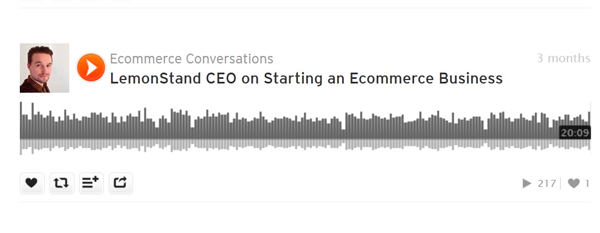
Danny Halarewich, CEO of LemonStand, an e-commerce platform specializing in startup businesses,
spoke on Practical Ecommerce’s “Ecommerce Conversations” podcast.
GRAND JUNCTION, Colo.—E-commerce isn’t new, but it’s new enough to intimidate many brick-and-mortar businesses who are considering selling online. Those willing to explore adding e-tail into their business can be confounded by the process and options they face when choosing a platform or service to use. In a recent podcast from
Practical Ecommerce, an online resource with articles and commentary from e-comm experts, LemonStand CEO Danny Halarewich shares what to look for and what to avoid when launching an e-commerce business.

Kerry Murdock,
publisher and editor,
Practical Ecommerce.
LemonStand is e-commerce platform founded in 2010 by Halarewich and co-founder, Aleksy Bobkov, in Vancouver, BC. The company currently hosts over 2,000 retail businesses for clients in a variety of industries, such as
JadoPado, an online store environment for technology products,
Zippo Canada,
The Anthony Robbins Foundation and
Raen, a boutique eyewear brand based in Oceanside, Calif.
Though LemonStand caters to businesses of all sizes and types, the platform specializes in growing and maintaining new businesses and brick-and-mortars looking to expand into the online space, a stance that Murdock found useful for Practical Ecommerce podcast listeners.
The conversation
(LemonStand CEO on
Starting an Ecommerce Business)
is geared toward those interested in learning a few quick tips about launching an online store, revolving around issues entrepreneurs may face when starting one and whether the undertaking is worthwhile for small businesses. Halarewich, to no surprise, believes that now is a better time than ever to take the step into online sales.
“Technology is much better in terms of effectiveness, the barrier to entry is a lot lower and also, people are just much more comfortable buying online. I think that things are definitely aligning and this probably makes it the best time in history to start an e-commerce business,” said Halarewich. “But there’s definitely more competition out there—we always say, it’s not a ‘build it and they will come thing anymore’—and it might not have ever been, but it’s definitely true today.”
What Halarewich means is that businesses seeking an e-commerce site need to ensure that they’re offering a seamless shopping experience, or in his words, “keeping up with the times” by taking advantage of modern approaches to digital marketing. Two key elements he pointed out are identifying your niche and finding the right way to fill it.
“First of all, learn a little bit more about your customers. Really identify exactly who they are. Research them, speak to them, find out everything you can and then compile that into a customer persona document and use that as a guide.”
Some questions e-comm starters might ask themselves about their customers are:
- How do they want to purchase your product? (Is your service subscription based?)
- How do they want the product to be shipped?
- Where are they located?
- Where do they hang out online?
- How and where can you reach them with your marketing messages?
“All these things should inform your decisions,” Halarewich said. “Armed with that information, you can narrow down your choices as far as your e-commerce platforms go.”
Once you’ve narrowed it down and selected the right platform, Halarewich suggests a professional approach to the site’s maintenance, whether it be built in-house or through a freelancer, studio or web design agency.
“It’s more than just building the website—it’s your branding, it’s your design,” he said.
The biggest misconception that startup entrepreneurs and small businesses have when starting their store is that once it is built, the customers will come, Halarewich reiterated.
“It’s really easy to launch a store nowadays—you can literally get one up in 15 minutes—that isn’t really the challenge anymore. The challenge is getting customers. Businesses often fail because they’re not investing in marketing,” Halarewich said, whether that investment be money or time.
“Look for an e-commerce platform that you can grow into and will grow with you,” he said. “There’s no way to predict the things you’ll need in the future.”
And finally, Halarewich noted, don’t forget mobile. “[Mobile is] hugely important nowadays and not really something that’s optional,” he said. “Make sure you are considering mobile shoppers right away and you’re providing a seamless browsing and shopping experience.”